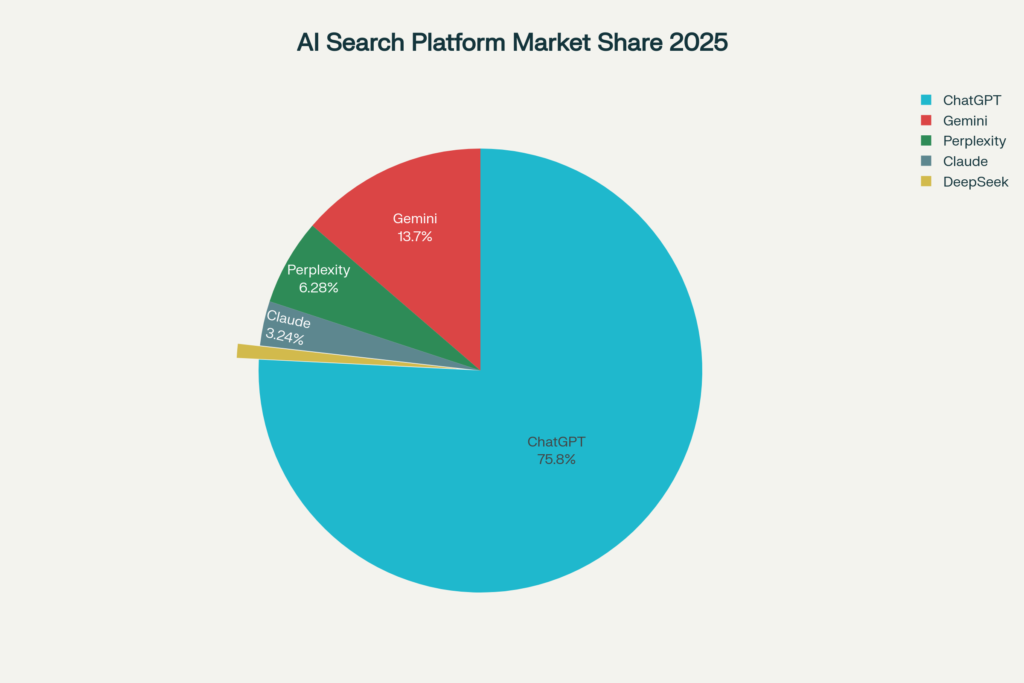As AI search evolves, educators must think in terms of Generative Engine Optimization (GEO), which focuses on gaining visibility within AI-generated responses rather than traditional rankings.

The education industry in 2025 is witnessing a fundamental transformation driven by AI-powered search, generative algorithms, and topic modeling frameworks that redefine how learners discover and consume knowledge.
With AI Overviews now appearing in over 57% of Google SERPs and zero-click searches climbing past 58.5%, traditional SEO strategies no longer guarantee visibility.
Institutions and course creators must now embrace AI-based topic modeling to build structured, sourceworthy, and trust-driven content ecosystems that align with new ranking factors.
Beyond keyword optimization, success depends on leveraging AI content algorithm trust signals, aligning with E-E-A-T optimization for AI search, and deploying structured data strategies that AI models can parse.
This article explores strategies to guide comprehensive course content creation, from AI citation optimization strategies 2025 to content quality measurement AI algorithms, ensuring that educational content not only attracts visibility but also earns long-term trust in an AI-first knowledge economy.
1. Understanding AI-Based Topic Modeling in Education
AI-based topic modeling is no longer an experimental concept but a mainstream approach shaping how educational content is developed and consumed.

By analyzing massive volumes of data, AI systems cluster related concepts and map knowledge ecosystems that better reflect real learner journeys.
For educators, this means course design must move away from isolated modules and toward interconnected themes that represent how learners actually search, ask questions, and build expertise.
A quantum machine learning basics course, for example, cannot stand alone without being linked to subjects like LLM fine-tuning educational datasets or ethical AI decision-making training.
Key advantages include:
- Concept clustering: AI identifies overlapping subjects (e.g., quantum computing, cryptography, and AI ethics) and organizes them into cohesive modules.
- Contextual depth: Models use semantic analysis to anticipate learner intent and propose complementary learning paths.
- Adaptive personalization: Topic modeling dynamically reshapes learning sequences for neurodivergent learners or multilingual audiences.
Example: Coursera and edX have begun deploying AI search optimization techniques to map student demand trends, tailoring courses for executive AI literacy training or ethical AI decision-making training. These platforms rely heavily on content quality measurement AI algorithms to ensure module-level coherence and learner engagement.
In practice, course creators must view topic modeling as an E-E-A-T optimization for AI search, ensuring firsthand expertise and authoritative sources form the backbone of course structures.
2. AI Search Ranking Factors 2025: What Educators Must Know
The way AI evaluates educational content in 2025 reflects a dramatic departure from earlier search frameworks. Visibility now depends on AI search ranking factors in 2025 that go beyond backlinks or keyword placement.

Trust signals are central.
AI systems prioritize firsthand experience, such as instructors sharing practical classroom results or publishing case studies with measurable outcomes.
They also favor content that is structured around entities rather than keywords, recognizing the relationships between concepts like AI-powered learning path optimization and low-resource language AI education.
Key AI search ranking factors 2025 include:
- Experience signals: AI favors firsthand teaching experiences, case studies, or course reviews that include phrases like “when we applied this in class.”
- Entity relationships: Structured connections between topics (e.g., linking quantum machine learning basics course to LLM fine-tuning educational datasets) drive higher inclusion rates.
- Freshness metrics: Courses updated within 12 months are 4.6 positions more likely to appear in AI citations.
- Structured data markup: Schema.org for courses, FAQs, and how-to modules supports retrieval and algorithmic trust.
Freshness is equally critical. Content updated within the past year is significantly more likely to appear in AI citations, reflecting the demand for up-to-date knowledge in fast-evolving fields.
At the same time, structured data has become indispensable. Markup for courses, FAQs, and how-to guides is no longer optional but necessary for AI content algorithm trust signals. The message is clear: without addressing these ranking factors, educational portals risk invisibility in the AI-driven search environment.
Platforms like Google Classroom and Moodle are embedding these AI search optimization techniques to ensure lesson modules surface in AI Overviews.
Educators adopting zero-click search prevention methods, such as embedding comprehensive answers but prompting deeper exploration in course portals, achieve higher learner acquisition.
Understanding these ranking factors is essential for AI citation optimization strategies 2025, ensuring your course content is AI-visible and learner-relevant.
3. Generative Engine Optimization Checklist for Course Creators
As search evolves, educators must think in terms of Generative Engine Optimization (GEO), which focuses on gaining visibility within AI-generated responses rather than traditional rankings.

Following a generative engine optimization checklist provides a strategic framework for success. At its core, GEO emphasizes the need for structured data, entity-based optimization, and demonstrable expertise.
For course creators, this means designing learning modules that AI can parse at a granular level, while also showcasing the credibility of instructors through detailed bios, professional certifications, and research contributions.
Core Checklist Items
- Schema-first design: Implement structured metadata for Course, Article, FAQPage, and HowTo to ensure AI systems can parse module details.
- Entity mapping: Build topical clusters—linking lessons like AI-powered learning path optimization with low-resource language AI education.
- Source credibility: Highlight author bios with certifications and practical experience to align with E-E-A-T optimization for AI search.
- Hybrid authorship: Combine AI-assisted drafts with human expert reviews, reinforcing AI content algorithm trust signals.
- Citable micro-datasets: Publish module-specific datasets (CSV/Excel) to enhance authority and AI citation optimization strategies 2025.
Example in Action
An Indian edtech firm deploying this checklist reported a 43% improvement in AI Overview citations for their data analytics courses. By embedding structured datasets, FAQs, and verified instructor credentials, their content earned recognition as “sourceworthy.”
This generative engine optimization checklist provides a repeatable roadmap for educators, bridging course creation with how to optimize content for AI overviews and reducing dependence on unpredictable search algorithms.
4. Building Sourceworthy Content for AI Overviews
In an era where algorithms synthesize information rather than merely listing links, the concept of sourceworthy content has emerged as a defining principle. AI Overviews seek out content that demonstrates originality, transparency, and reproducibility.

Educational providers that want their material to appear in AI responses must embed evidence of firsthand experience, verifiable data, and transparent authorship into every course module.
Steps to Sourceworthy Course Content
- Embed firsthand experience: Case studies where educators document real-world results of teaching methods.
- Provide verifiable data: Include original surveys, academic references, or micro-studies supporting lesson claims.
- Transparency: Add disclaimers for AI-assisted drafting and clearly attribute external sources.
- Multimodal enrichment: Add transcripts, visuals, and video modules to improve multimodal retrieval.
For instance, Harvard Business School Online improved its AI citations by publishing case-study-driven MBA modules that align with AI content algorithm trust signals.
Similarly, universities piloting AI compliance training programs demonstrate sourceworthiness through detailed faculty bios and reproducible methodologies.
By adopting this sourceworthy content creation guide, institutions can safeguard against zero-click search prevention methods undermining their web traffic. Instead, their courses become definitive answers that AI models prefer citing—turning visibility challenges into authority-building opportunities.
5. Zero-Click Search Prevention in Education Portals
The rise of zero-click searches has intensified competition for attention. Nearly 60% of all queries in 2025 are resolved directly within AI summaries, leaving little incentive for users to visit sources.

For education portals, this poses a risk of losing traffic and enrollment opportunities. However, zero-click search prevention methods provide a way to mitigate these losses by encouraging deeper learner engagement.
Prevention Strategies
- Layered answers: Provide concise, AI-friendly responses but withhold in-depth frameworks available only within course portals.
- Conversational structuring: Frame headers as questions (“How does AI topic modeling improve pedagogy?”) that AI can cite, while deeper modules are gated.
- Exclusive datasets: Share proprietary learning data, accessible only after sign-up.
- Contextual CTAs: Insert “explore full course module” prompts to convert AI readers into students.
Example: A European edtech startup reduced referral losses by 32% after implementing layered content strategies. Their “free summaries” gained AI visibility, while detailed walkthroughs drove registrations.
Ultimately, zero-click search prevention methods focus on balancing AI inclusivity with sustainable course monetization. Without these strategies, publishers risk being quoted without recognition, diminishing both brand visibility and learner acquisition potential.
6. Measuring Content Quality Through AI Algorithms
The ability to measure content quality has been revolutionized by algorithms capable of evaluating far more than surface-level metrics. Content quality measurement AI algorithms assess not just accuracy but engagement, coherence, and authority.

They reward educational content that demonstrates consistency across modules, provides updated references, and reflects strong author credentials.
Key Quality Signals
- Engagement depth: AI measures time-on-page and learner quiz completions as proof of value.
- Consistency across modules: Aligned terminology and concepts reinforce authority in topic clusters.
- Update frequency: Courses refreshed with new research every 6–12 months rank higher in AI search ranking factors in 2025.
- Trust metrics: Clear author credentials, HTTPS, and cross-referenced citations improve inclusion odds.
Edtech companies like Byju’s and Khan Academy have begun integrating these quality signals into their content workflows. Their internal dashboards now include “AI readiness scores,” blending AI content algorithm trust signals with engagement metrics.
By mastering these AI search optimization techniques, educators ensure that courses meet not just human learning needs but also the expectations of AI-driven search. This dual-layer strategy is what transforms content from “teachable” to “sourceworthy.”
Conclusion
AI-based topic modeling has ushered in a new era where content must satisfy both learners and algorithms. By understanding AI search ranking factors 2025, leveraging a generative engine optimization checklist, and mastering AI citation optimization strategies 2025, course creators can future-proof their visibility.
Preventing traffic loss through zero-click search prevention methods and prioritizing E-E-A-T optimization for AI search ensures that courses are recognized as authoritative, trustworthy, and citation-ready.
The ultimate lesson is clear: success lies not in fighting AI search but in aligning with it. Educational institutions that integrate content quality measurement AI algorithms, human oversight, and proprietary insights will dominate AI citations.
As AI Overviews increasingly determine what learners see first, sourceworthy content creation guides will separate leading institutions from those left invisible.
The winners will be the educators who embrace AI search optimization techniques—transforming courses into trusted answers in the AI-first learning landscape.


